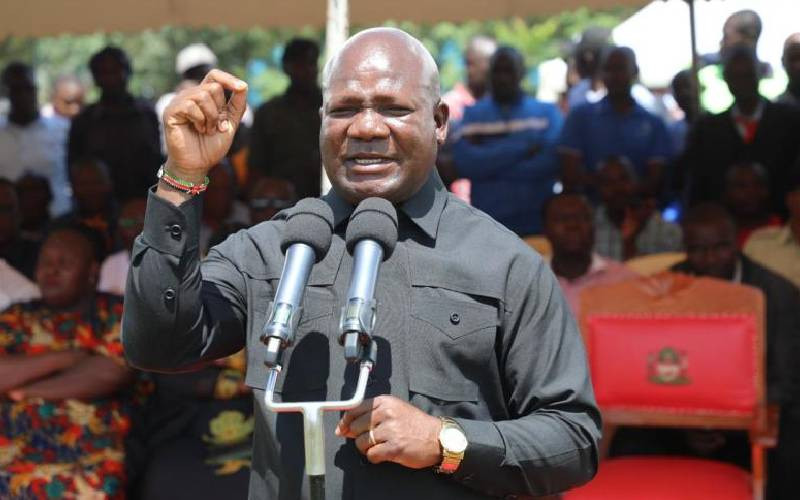Climate change is one of the greatest challenges facing humanity in the 21st century. In Kenya like many other African countries, climate change is intensifying at an alarming rate as is evident from the current drought that is ravaging many parts of the country.
The National Drought Management Authority (NDMA) has declared Kilifi County to be at alarm drought phase while it has put out an alert for Tana River, Garissa, Taita Taveta, Narok, Meru (North), Mandera. The government estimates that about 1.3 million people mostly in these arid and semi-arid areas are affected. This drought reminds us that climate change is a reality that already affects hundreds of millions among us.
One of the mitigating interventions that the country should put in place is to promote investments that work towards attaining the goal of using 100% renewable energy from sources such as solar, geothermal, tidal waves, the wind and even municipal waste as opposed to using fossil fuel – generated power.
This is one of the issues discussed over the past two weeks (7-18 November 2016) at the 22nd UN Framework Convention on Climate Change Conference of Parties (COP22) in Marrakech, Morocco. UN Secretary General Ban Ki-Moon told the conference that African countries bear the brunt of climate change “compared to the global average, temperatures are rising higher in this continent. Out of the 50 countries hit hardest by climate change, 36 are in Africa”.
According to COP22 President Salaheddine Mezouar developing renewable energy should become part of the sustainable development agenda of all the countries, in particular of the most vulnerable ones. “Renewable energies do not only mitigate our impact on climate change but open the way to new models of sustainable development with new investments, new industries, and new jobs,”Mezouar said. “We should all embrace the opportunities offered by the development of renewable energies."
Kenya was represented by a delegation led by President Uhuru Kenyatta who informed the conference that Kenya now has a Climate Change Act and a National Adaptation Plan (NAP) that were developed through multi-stakeholder engagement. “The Act strengthens climate change governance, institutional arrangements, and mainstreaming of climate change into sectoral planning, budgeting, and implementation at all levels of government,” the President said.
Though Kenya has made significant progress in adopting renewable energy efforts to achieve the 100% RE target should be intensified. 51% of the country’s electricity needs are met through geothermal production this is set to increase when the Lake Turkana Wind Power project starts supplying electricity to the national grid. The government must accelerate the development and implementation of its renewable energy projects by showcasing them to the open market and looking to attract private sector participation and investment as agreed under the Africa Renewable Energy Initiative that was endorsed by the AU Summit in June 2016.
During COP22 the African Development Bank (AfDB) announced that over the next five years, Kenya among other African countries will benefit from a $12 billion (Ksh1.2 trillion) facility to fund renewable energy projects under the Africa Renewable Energy Initiative. The bank’s president Akiwumi Adesina said the fund will help African countries add value to what they produce and speed up industrialization. “This must start with unlocking the huge amounts of energy potential on the continent, including the vast potentials in renewable and non-renewable energy, he added. The initiative targets to deliver 10 Gigawatts of electricity by 2020 and 300 Gigawatts by 2030.
The bank is also asking global finance institutions to support Africa to adapt to climate change and stop the displacement of public spending caused by climate change “Words of comfort are not enough to pay Africa’s rising bills for adapting to climate change,” said Adesina
County Governments, institutions, and households should also be encouraged to work towards 100% renewable energy because it is technically possible, economically advisable, socially imperative and environmentally inevitable. This is because we must all play a role in stopping greenhouse gas emissions through a phased elimination of fossil fuels if we are to avoid the worst impacts of climate change.
University campuses, for example, are large energy consumers and have a continuous need for electricity, heating, and cooling. Given the large power needs of these campuses, the benefits of using renewable energy sources for power are enormous. This includes having a reliable and constant access to power, reduced energy costs and a smaller carbon footprint.
One of the leading institutions in the adoption of renewable energy is Strathmore University in Nairobi, Kenya. The university established the Strathmore Energy Research Centre (SERC) four years ago with the aim of carrying out high-quality research and technical training as well as consultancy services in the energy sector in Kenya.
Reports indicating that Kenya will go on with plans to construct its first ever nuclear power plant defying calls from experts who have urged the country to focus on developing renewable energy, are therefore depressing considering the dangers posed by atomic technology. Kenya is not ready for nuclear technology and I hope we never will. Countries such as Italy, Germany and Switzerland are phasing out the use of Nuclear power. It is, however, encouraging that the government decided to discontinue the Lamu coal power plant that would have had detrimental environmental impacts on the Lamu ecosystem.
Stay informed. Subscribe to our newsletter
 The Standard Group Plc is a
multi-media organization with investments in media platforms spanning newspaper
print operations, television, radio broadcasting, digital and online services. The
Standard Group is recognized as a leading multi-media house in Kenya with a key
influence in matters of national and international interest.
The Standard Group Plc is a
multi-media organization with investments in media platforms spanning newspaper
print operations, television, radio broadcasting, digital and online services. The
Standard Group is recognized as a leading multi-media house in Kenya with a key
influence in matters of national and international interest.
 The Standard Group Plc is a
multi-media organization with investments in media platforms spanning newspaper
print operations, television, radio broadcasting, digital and online services. The
Standard Group is recognized as a leading multi-media house in Kenya with a key
influence in matters of national and international interest.
The Standard Group Plc is a
multi-media organization with investments in media platforms spanning newspaper
print operations, television, radio broadcasting, digital and online services. The
Standard Group is recognized as a leading multi-media house in Kenya with a key
influence in matters of national and international interest.







